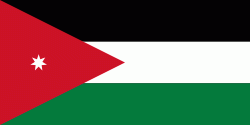Irbid
 |
Irbid is located about 70 km north of Amman on the northern ridge of the Gilead, equidistant from Pella, Beit Ras (Capitolias), and Um Qais, and approximately 20 km south of the Syrian border.
Irbid was built on successive Early Bronze Age settlements and was possibly the biblical Beth Arbel and the Arbila of the Decapolis, a Hellenistic league of the 1st-2nd century BCE. The population of Irbid swelled in the late 19th century, and prior to 1948 it served as a significant centre of transit trade.
The city is a major ground transportation hub between Amman, Syria to the north, and Mafraq to the east.
The Irbid region is also home to several colleges and universities. The two most prominent universities are Jordan University of Science and Technology and Yarmouk University.
Artifacts and graves in the area show that Irbid was inhabited in the Bronze Age. Pieces of pottery and wall stones found at Tell Irbid were estimated to be made in the year 3200 B.C. In the Hellenistic period, Irbid, then known as Arabella was a major trade center. Before the advent of Islam, Arabella was famous for producing some of the best wines in the ancient world. The area in the region had extremely fertile soil and moderate climate, allowing the growing of high quality grapes.
After the Muslim conquests, the city came under the rule of the Muslim Empire and became known as Irbid, at which time it shifted from wine to olive oil production. Wheat was also an important product in the area.
In 1596 it appeared in the Ottoman tax registers named as Irbid, situated in the nahiya (subdistrict) of Bani Juhma, part of the Sanjak of Hawran. It had 72 households and 35 bachelors; all Muslim. The villagers paid a fixed tax-rate of 25% on agricultural products; including wheat (22,500 akçe), barley, summer crops, fruit trees, goats and bee-hives; in addition to a market toll. The total tax was 38,116 akçe.
In 1838, Eli Smith noted Irbid (Arbela) as being a place with Sunni Muslim.
The Jordanian census of 1961 found 44,585 inhabitants in Irbid.
Map - Irbid
Map
Country - Jordan
 |
 |
| Flag of Jordan | |
Modern-day Jordan has been inhabited by humans since the Paleolithic period. Three stable kingdoms emerged there at the end of the Bronze Age: Ammon, Moab and Edom. In the third century BC, the Arab Nabataeans established their Kingdom with Petra as the capital. Later rulers of the Transjordan region include the Assyrian, Babylonian, Roman, Byzantine, Rashidun, Umayyad, Abbasid, and the Ottoman empires. After the Great Arab Revolt against the Ottomans in 1916 during World War I, the Greater Syria region was partitioned by Britain and France. The Emirate of Transjordan was established in 1921 by the Hashemite, then Emir, Abdullah I, and the emirate became a British protectorate. In 1946, Jordan gained independence and became officially known in Arabic as the Hashemite Kingdom of Jordan. The country captured the West Bank during the 1948 Arab–Israeli War and annexed it until it was lost to Israel in 1967. Jordan renounced its claim to the territory in 1988, and became the second Arab state to sign a peace treaty with Israel in 1994.
Currency / Language
| ISO | Currency | Symbol | Significant figures |
|---|---|---|---|
| JOD | Jordanian dinar | دا | 3 |
| ISO | Language |
|---|---|
| AR | Arabic language |
| EN | English language |















